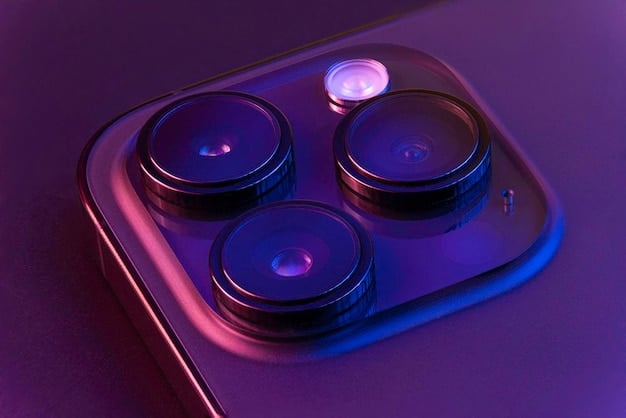Unveiled: Top 3 Smartphone Camera Innovations Expected in 2025

Unveiled: The 3 Most Anticipated Smartphone Camera Innovations of 2025 are set to revolutionize mobile photography with computational imaging, advanced sensor technology, and AI-driven enhancements, promising users unprecedented image quality and creative possibilities.
Get ready to say cheese to the future! The world of smartphone photography is on the cusp of another leap forward. Let’s dive into
Revolutionizing Mobile Photography: The 2025 Landscape
The smartphone camera has evolved from a simple add-on to a critical feature for consumers. As we look ahead to 2025, several key innovations are poised to redefine what’s possible in mobile photography. These advancements promise not just better image quality, but also more creative control and enhanced user experiences. We need to recognize the paradigm shifts that will change the market, and what we can expect from the best smartphone camera technologies.
Computational Imaging Breakthroughs
Computational imaging is not new, but its sophistication is rapidly increasing. Expect to see algorithms that can reconstruct images with incredible detail, even in challenging lighting conditions. The newest smartphones will leverage AI to understand scenes and optimize settings automatically.
Sensor Technology Advancements
Bigger sensors, improved pixel designs, and new materials are all contributing to better image capture. These advancements will enhance dynamic range, reduce noise, and improve low-light performance. Sensor technology advancements will also improve image processing efficiency.
We can’t forget that software processing is essential to image capturing. New software will make it easier for us to create the exact images we desire. You will be able to edit everything from the color to the aperture from the ease of your own device.
- Enhanced HDR capabilities for balanced exposures
- Improved low-light performance with reduced noise
- Real-time scene recognition and optimization
In conclusion, the innovations coming to smartphone cameras in 2025 will create a big shift in terms of the use of mobile technologies. We should see the biggest changes in software and imaging quality, which will affect how photos are edited and taken and can be used by people of all backgrounds.
AI-Powered Photography: Smart Camera Features
Artificial intelligence is playing an increasingly important role in smartphone cameras. In 2025, expect AI to be even more deeply integrated, offering smart features that automate complex tasks and enhance creative possibilities. Beyond automatic adjustments, AI will enable entirely new ways to capture and manipulate images.
Intelligent Scene Recognition
AI algorithms will be able to identify objects, people, and scenes with greater accuracy, automatically adjusting camera settings to optimize image quality. This means no more fiddling with manual controls; the camera will intelligently adapt to any situation, with its adjustments so finely optimized.
AI-Driven Image Enhancement
AI will be used to enhance images in real-time, correcting imperfections, sharpening details, and even adding stylistic effects. This means you can get professional-looking photos without needing to use editing software. These effects will become a seamless addition, easily accessible and effortless to use. Think of filters, but on a whole new level.

- Object tracking for sharp focus on moving subjects
- Automatic portrait mode with natural-looking bokeh
- AI-powered zoom for clearer zoomed-in shots
The innovations coming to smartphone cameras with AI will be essential to the user experience. They will make the process much more efficient, and the images will also become much different than before with so much editing and options available. Software will change to become much more dynamic, customizable, and easier to use.
Advanced Sensor Technology: Pushing Image Quality
The heart of any camera is its sensor. In 2025, expect to see significant advancements in sensor technology that will lead to better image quality, improved low-light performance, and greater dynamic range. These improvements will allow smartphones to compete with traditional cameras in more scenarios.
Larger Sensor Sizes
Bigger sensors capture more light, resulting in better image quality, especially in low-light conditions. Expect to see flagship smartphones with sensor sizes approaching those of dedicated cameras. The improvements will be so big that standard phones users have today will be unrecognizable.
New Pixel Designs
Innovative pixel designs, such as stacked pixels and improved light collection techniques, will further enhance image quality. These technologies will allow sensors to capture more information with greater efficiency. Expect improvements to colors, imaging, clarity, and brightness.
Beyond the innovations to sensor size and pixel designs, we are expected to see improvements to zoom and depth of field. Both of these essential tools will become a lot more powerful, giving people the chance to capture things in greater detail easier than ever, all within their phones.
- Improved dynamic range for more detail in highlights and shadows
- Better low-light performance with reduced noise
- Faster readout speeds for capturing fast-moving subjects
The focus of improved sensor technology goes beyond mere image clarity; it aims to redefine the very essence of how smartphones capture and process visual data. These advancements serve as the backbone for future innovations, paving the way for mobile photography that rivals professional equipment.
Computational Photography: Redefining Image Capture
Computational photography uses software algorithms to enhance images in ways that were previously impossible. In 2025, expect to see even more sophisticated computational photography techniques that will blur the line between reality and digital manipulation. This allows for dynamic image processing and completely changes how photos are viewed.
Super-Resolution Imaging
Super-resolution algorithms combine multiple frames to create a single image with greater detail than any individual frame could capture. This technique will allow smartphones to produce images that rival those from higher-resolution cameras.
Advanced HDR Techniques
High dynamic range (HDR) imaging is used to capture scenes with a wide range of brightness levels. In 2025, expect to see advanced HDR techniques that can produce even more natural-looking images with greater detail in both highlights and shadows.

These advanced HDR techniques will allow for brighter exposures in even the darkest environments. Expect phones to have an easier time taking pictures in a variety of settings as these technologies become more implemented. This should be seen as a win for those who like to take pictures in a place like a nightclub or a restaurant
- Night mode advancements with brighter and clearer images
- Improved portrait mode with more accurate depth mapping
- Real-time bokeh effects with adjustable blur
Computational photography represents a convergence of hardware and software capabilities, leading to new possibilities in mobile photography. Its transformative power lies in its continuous evolution, promising even more ground-breaking advancements that will impact the future of the industry.
The Impact on Social Media and Content Creation
These camera innovations will have a significant impact on social media and content creation. Users will be able to capture higher-quality photos and videos, making their content more engaging and visually appealing. This will further blur the line between amateur and professional content creation.
Enhanced Visual Storytelling
The improved image quality and creative features will enable users to tell more compelling visual stories. Social media feeds will be filled with more stunning photos and videos, capturing the attention of viewers.
Empowering Content Creators
These innovations will empower content creators to produce professional-quality content with just their smartphones. This will lower the barrier to entry and allow more people to share their stories with the world.
Besides storytelling, all of this new technology will allow even further personalization of the images people make. Using their style with the dynamic and customizable tools of the newest phones, people will be able to make more impactful content than ever before, changing the way people create and enjoy photos.
- Increased engagement on social media platforms
- Higher-quality content creation for marketing and advertising
- New opportunities for visual artists and storytellers
The innovations that are coming signal the democratization of high-quality content creation. As smartphones become more powerful and versatile, users gain new creative tools and expand their ability to communicate visually, leaving their own special mark.
Challenges and Future Directions
Despite the exciting advancements, there are also challenges to overcome. One challenge is managing the increasing complexity of camera systems and software. Another is ensuring that AI-powered features are used ethically and responsibly. Understanding these future implications will allow for more innovation in this space.
Ethical Considerations
As AI becomes more powerful, it is important to consider the ethical implications of using it to manipulate images. There is a risk that AI could be used to create fake or misleading content, which could have serious consequences.
Balancing Automation and User Control
While AI can automate many tasks, it is important to maintain a balance between automation and user control. Users should still have the ability to adjust camera settings and express their own creative vision. People want to feel that they are in charge of their art, not an AI.
These phones also need to remain affordable to most people around the world. While the high-end market is nice and always improving, the lower end needs to be constantly updated as well, making sure everyone has access to all of these technologies.
- Addressing privacy concerns related to AI-powered features
- Developing standards for ethical use of AI in photography
- Promoting transparency in image manipulation
Addressing challenges and setting a clear direction will be of great importance for the future and continued evolution around phone camera technologies. By understanding the implications of the tech coming, we can ensure that these features are developed in a way that benefits society while also empowering individuals to be more creative.
| Key Aspect | Brief Description |
|---|---|
| 📸 Computational Imaging | Algorithms reconstruct images for incredible detail. |
| 🤖 AI-Powered Features | AI automates complex tasks and enhances creative options. |
| 💡 Sensor Technology | Larger sensors improve low-light and dynamic range. |
| 📱 Social Media Impact | Content creators empowered, visual storytelling enhanced. |
Frequently Asked Questions
▼
Computational imaging uses algorithms to enhance images beyond what the sensor alone can capture. It allows for better detail, clarity, and overall image quality by computationally reconstructing the image.
▼
AI will automate complex tasks, such as scene recognition and image enhancement, making it easier for users to capture high-quality photos. It will also enable new creative possibilities, such as real-time stylistic effects.
▼
Larger sensors capture more light, improving image quality, especially in low-light conditions. They also increase dynamic range, allowing for more detail in both highlights and shadows in the images created.
▼
These innovations will enable users to create higher-quality and more visually appealing content, leading to increased engagement on social media platforms. It will blur the line between amateur and professional content.
▼
There are concerns that AI could be used to create fake or misleading content. It is important to consider the ethical implications and promote transparency in image manipulation to combat these issues.
Conclusion
As we look to 2025, the innovations in smartphone camera technology promise to revolutionize the way we capture and share our world. From AI-powered enhancements to advanced sensor technology and computational photography, these advancements will empower users to create stunning photos and videos with ease. However, it is important to address the ethical considerations and ensure that these technologies are used responsibly for the betterment of society.




![Quantum Computing for Beginners: A US Geek's Guide [2025] Quantum Computing for Beginners: A US Geek's Guide [2025] - Cover Image](https://dorama2you.com/wp-content/uploads/2025/06/dorama2you.com_3_1749769492_79bdbcc1_cover-360x180.jpg)
